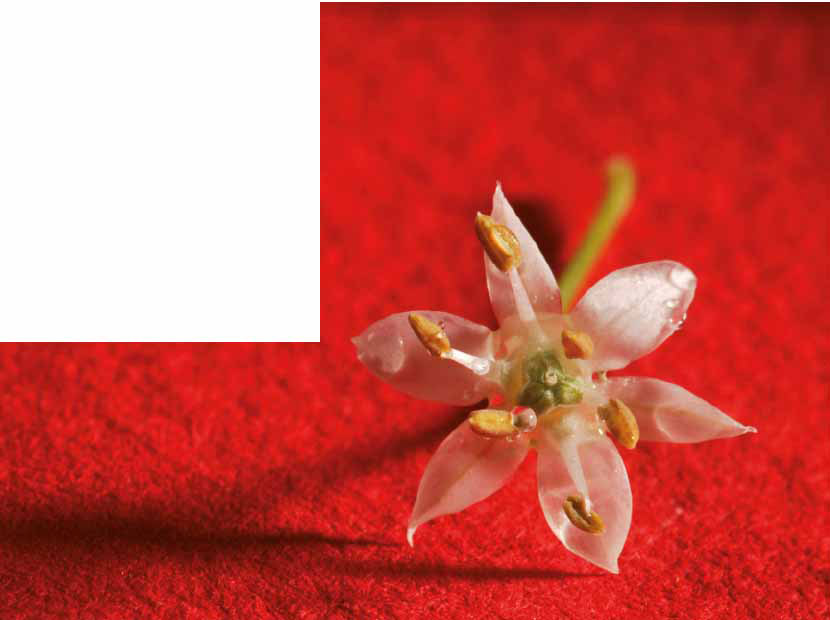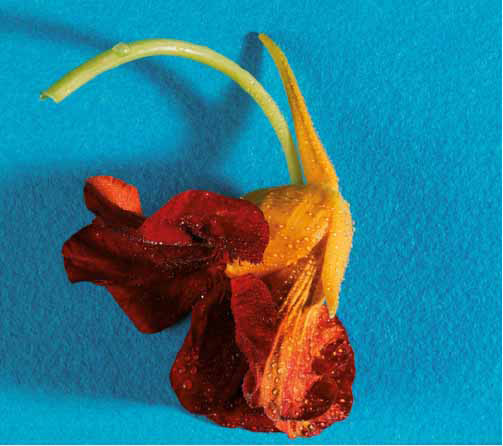
Cooking with flowers is neither strange nor cutting edge. You just need to read through gastronomic literature to see that, in cookery, almost everything has already been done before. To discover that the use of flowers is as old as it is natural, just go back to classical antiquity and look at how the Romans perfumed their dishes. In Apicius’s recipes, there is mention of rose petals, marjoram flowers in mincemeat, and sauces made from saffron-coloured safflowers, and even wine aromatized with roses or violets. He specifically speaks of rose cakes, scented and adorned with rose petals. The Romans were also fascinated by mallow flowers, and apparently Charlemagne loved them in salads, just as in the late medieval ages, tuberoses were the showy whim of several French kings in more than one dish.
A few centuries earlier, in The Odyssey, Homer speaks of a country whose inhabitants eat lotus flowers. A reference which isn’t strange when you consider that these flowers have been used since time immemorial in Chinese cuisine, along with others, such as magnolia and jasmine. Similarly, delicate Japanese cuisine uses chrysanthemums, among other flowers, in certain dishes, especially at New Year, as well as in some salads in the last months of the year.
According to Eduardo Mendez Ries in his interesting Gourmet Dictionary, it was precisely these Japanese influences that Prosper Montagne, famous chef and scholar in Paris between the wars, ‘imbibed’, when he created Salade Francillon, which incorporates them.
In the Middle East and Far East, orange and rose blossoms have been used since ancient times, whereas the Mediterranean regions opted for pumpkin and zucchini flowers, both as starters and garnishes, stuffed, fried, etcetera.
In the Middle East dried rose buds are mostly used as condiments, and jams are made with rose petals. But it is in the Far East, as already mentioned, that flowers are most often involved in cookery itself. Chrysanthemum or magnolia petals are very common in salads, jasmine and hibiscus flowers with poultry and fish, and yellow lily is used to season sauces and soups, to give a few examples. Tuberoses are highly relevant in various specialities of Hindustani cookery, while in Indonesia jasmine flowers are used to flavour chicken and other poultry dishes. Rose petals ‘reign’ in countries like Algeria or Tunisia, where they are widely used to perfume dishes like couscous or lamb stews. In our own Europe flowers are especially used in a flavouring drinks and liquors. Their role in salads is usually limited to a mainly decorative function, but butters are often found to be flavoured with jasmine petals, orange, lemon or garlic. Flowering mint holds a thousand charms with fish, as do lime flowers and jasmine, which can also be mixed with some stuffings. Wild violets are happily married to ox, savoury flowers with beef, sage with pork tripe, and mint and thyme with lamb. Another culinary flower, which we have already mentioned, is the zucchini, so fashionable among the Nice chefs back in the eighties, and a particular highlight of the then ground-breaking chef Jacques Maximin.


And in France, this is not the only flower that is important in gastronomy; others, such as violets, have also left their mark on preparations for trout, pigeons, various omelettes and versions of scrambled eggs, not to mention aromatic sorbets, while in the Midi peach flowers were used in delicious salads.
In Spain, those who think cooking with flowers is innovative need look no further than Andalusia and the cookery manuals of the chefs to the Spanish monarchs of the 16th and 17th centuries, to realize that, long ago, they were used comprehensively. There are countless references to candied rose petals, pastries stuffed with elderberry jam, wallflower liquor, meat flavoured with orange blossom flowers... Refined customs that two chefs Diego Granado and Francisco Martínez Montiño, echoed entirely. Today, examples are more specific and fewer but no less interesting, despite the fact that there are no limits. You must always ensure, by all means possible, that the flowers enhance the flavour of the main ingredient and never mask it. This is well known by Albert Adrià, renowned ‘dessert chef’, as he showed some time ago in his delightful book, El Bulli Desserts, with exciting examples like ‘Iced Grapes with Hints of Flowers and Fruits’, which included fascinating sugared roses. Using the same flower, he created the ‘Sabayon of Roses and Rose Water Gelatine,’ which accompanied a cinnamon ice cream with tangerine granita. A dessert which, as the author noted, has clear resonances with Morocco.
But when choosing flowers for cookery, you must be very careful. You must follow guidelines almost as stringent as those for mushrooms. First, only use edible flowers and make sure they have not been treated with pesticides. Beware! Florists flowers are very pretty but they may have been treated with chemicals. When in doubt as to whether a flower is edible or not, it is best to consult an expert on the subject. Also bear in mind that you have to pick them in the daytime and in dry weather, and only those that will be used at once. Wash them in cool water, remove the stamens, pistils and the white base of the petals; otherwise they will have a slightly bitter taste. Don’t forget that some flowers like lavender, heather or roses can be dried for use out of season.
As for applications, some flowers are used because they provide delicate aromas and flavours. For example, lavender, rose petals, orange blossom and nasturtium often flavour things as disparate as sorbets, spirits, wines, teas, puddings, jams or jellies. Indeed, you can say that the nasturtium plant, native of Peru and initially known as Indian cress, is as culinary as pork or duck, in that every part is used. Its leaves, usually of a strong spicy flavour, are reminiscent of watercress, its flowers (yellow, orange, red or even a creamy colour) have a light fragrance and five long petals. Finally, the seeds are pickled like capers.
However, there are other flowers that are more appropriately decorative. This is the case with chrysanthemums, borage flowers, which are purple and very showy, variegated geraniums, and marigolds, which are yellow, and give beautiful colour to a salad, for example. But even if we say they are decorative, the sight of them also stimulates the palate and, therefore, they can arguably be said to give a remarkable taste sensation.